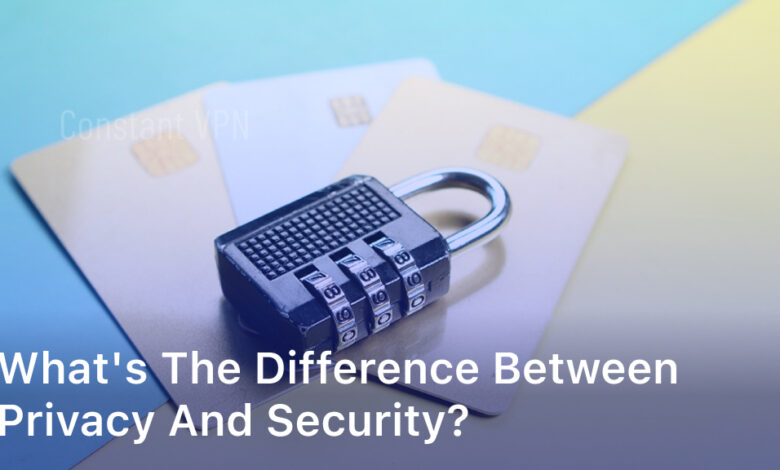
Privacy and security are two crucial concepts in today’s digital age, often used interchangeably but holding distinct meanings and implications. Let’s delve into the essence of each and explore the differences between them.

Understanding Privacy
Privacy refers to the right of individuals to control their personal information and determine how it is collected, used, and shared. It encompasses the boundaries individuals set regarding their personal data and the level of confidentiality they expect.
Definition of Privacy
Privacy can be defined as the fundamental right to autonomy and self-determination over one’s personal information. It encompasses the ability to maintain secrecy and control over sensitive data, ensuring that individuals have the freedom to make informed choices about their privacy.
Importance of Privacy
Privacy plays a vital role in safeguarding personal dignity, autonomy, and freedom. It fosters trust between individuals and institutions, ensuring that personal information is handled with care and respect. Moreover, privacy promotes innovation and creativity by providing individuals with the confidence to explore and express themselves freely.
Understanding Security
Security, on the other hand, pertains to the measures taken to protect individuals, organizations, and systems from various threats and vulnerabilities. It encompasses a broader spectrum, including physical security, cybersecurity, and information security.
Definition of Security
Security can be defined as the state of being free from danger, risk, or harm. It involves implementing measures to safeguard assets, prevent unauthorized access, and mitigate potential threats. Security measures aim to maintain the integrity, confidentiality, and availability of resources and information.
Importance of Security
Security is essential for ensuring the safety and well-being of individuals, organizations, and society as a whole. It helps protect against various threats, including cyberattacks, identity theft, fraud, and physical harm. By implementing robust security measures, individuals and organizations can mitigate risks and maintain trust and confidence in their operations.
Differences Between Privacy and Security
While privacy and security share common goals of protecting individuals and their information, they differ in several key aspects.
Nature of Protection
- Privacy: Focuses on controlling the collection, use, and dissemination of personal information to maintain confidentiality and autonomy.
- Security: Encompasses measures to safeguard individuals, organizations, and systems from various threats and vulnerabilities, including unauthorized access, breaches, and attacks.
Scope of Coverage
- Privacy: Concerned with protecting personal data and ensuring individual rights to privacy.
- Security: Extends beyond personal data to include physical assets, infrastructure, networks, and systems.
Focus of Concern
- Privacy: Centers on the individual’s right to control their personal information and maintain confidentiality.
- Security: Focuses on preventing unauthorized access, ensuring data integrity, and maintaining system availability.
Legal Framework
- Privacy: Governed by regulations and laws that dictate how personal data should be collected, processed, and protected.
- Security: Encompasses compliance with security standards, regulations, and industry best practices to safeguard assets and mitigate risks.
Role in Technology
- Privacy: Influences the design and implementation of technology to incorporate privacy-enhancing features and protect user data.
- Security: Integral to ensuring the confidentiality, integrity, and availability of technology systems and infrastructure.
Impact on Personal Data
Privacy concerns and security measures intersect in their impact on personal data, highlighting the importance of addressing both aspects to ensure comprehensive protection.
Privacy Concerns
Privacy concerns arise from the collection, use, and sharing of personal data without consent or transparency. Individuals may worry about potential misuse of their data, loss of privacy, and exposure to identity theft or surveillance.
Security Measures
Security measures aim to address privacy concerns by implementing safeguards to protect personal data from unauthorized access, breaches, and cyberattacks. These measures include encryption, access controls, authentication mechanisms, and security protocols.
Challenges and Risks
Despite efforts to protect privacy and enhance security, challenges and risks persist, necessitating ongoing vigilance and adaptation to emerging threats and vulnerabilities.
Privacy Risks
Privacy risks stem from data breaches, unauthorized access, surveillance, and the misuse of personal information by malicious actors or entities. These risks can lead to identity theft, financial fraud, reputational damage, and loss of trust.
Security Threats
Security threats encompass a wide range of risks, including malware, phishing attacks, ransomware, and social engineering tactics. These threats target vulnerabilities in systems, networks, and applications, posing risks to data confidentiality, integrity, and availability.
Balancing Privacy and Security
Achieving a balance between privacy and security is essential to promote trust, transparency, and accountability while addressing evolving threats and regulatory requirements.
Need for Balance
Balancing privacy and security requires a holistic approach that considers the rights and interests of individuals, organizations, and society. It involves implementing measures to protect personal data while ensuring adequate security controls to mitigate risks.
Ethical Considerations
Ethical considerations play a crucial role in shaping privacy and security practices, guiding decision-making and behavior in the use of technology and data. Upholding ethical principles such as transparency, fairness, and respect for individual rights is essential to building trust and fostering responsible data stewardship.
Conclusion
In conclusion, privacy and security are essential components of a robust and resilient digital ecosystem. While privacy focuses on protecting personal data and individual rights, security encompasses broader measures to safeguard individuals, organizations, and systems from various threats and vulnerabilities. By understanding the differences between privacy and security and addressing both aspects comprehensively, individuals and organizations can navigate the complexities of the digital landscape with confidence and trust.
FAQs
How does privacy differ from confidentiality?
Privacy refers to the individual’s right to control their personal information, while confidentiality pertains to the protection of sensitive data from unauthorized access or disclosure.
What are some common security measures to protect personal data?
Common security measures include encryption, access controls, multi-factor authentication, regular security audits, and employee training on cybersecurity best practices.
How can organizations balance the need for data privacy with the requirements of data security?
Organizations can achieve a balance between data privacy and security by implementing robust security controls, transparent data practices, and privacy-enhancing technologies while complying with relevant regulations and standards.
What are the potential consequences of failing to address privacy and security concerns?
Failing to address privacy and security concerns can result in data breaches, reputational




